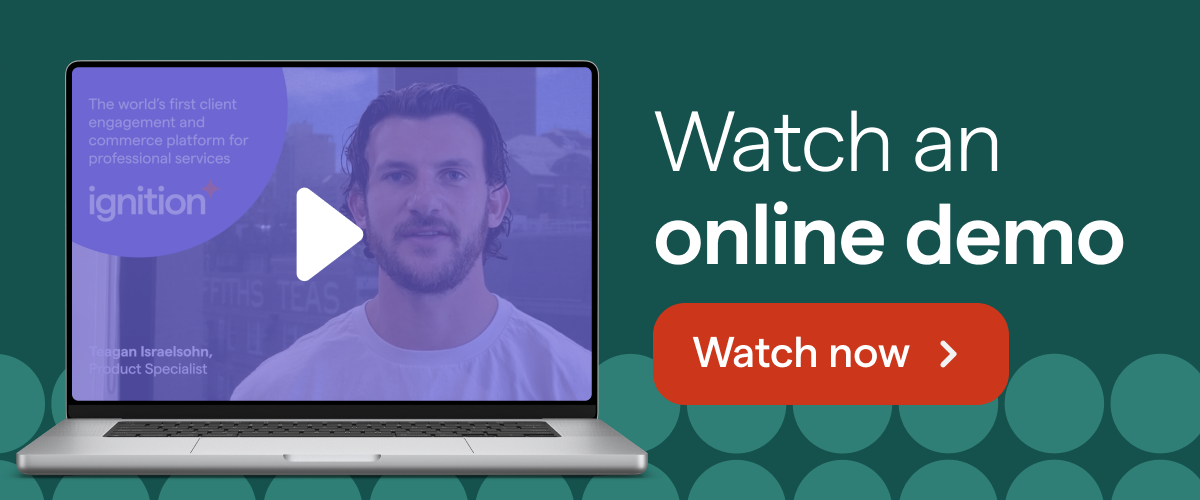How to create an effective client intake form

You've landed a new client and you’re excited to kick off your engagement and project. But before you do, there's certain information that you need.
If you're a marketing agency, you probably need their login details for platforms such as Facebook and Instagram, so you can run ads and post on their behalf. If you're a bookkeeper or accountant, you'll need pertinent details on their business financials and the software they use to manage their books.
To gather this information, it’s a good idea to start with a client intake form. And it’s essential to determine at the outset what information your form will gather.
Using a client intake form – preferably a digital form– can be a great way to collect this information in an organized and automated way.
With various intake form templates available, including specialized accounting firm client intake form templates, the client intake process becomes smoother. Let's dive in and discover more about how your firm can use client intake form templates and leverage automation software to streamline your onboarding process.
What is a client intake form? Your client intake form definition
A client intake form is a document professional service providers use to gather essential information from their clients at the beginning of their relationship. But why is it necessary for every client to fill out a client intake form? Simply, it ensures you consistently capture all pertinent details.
It's a structured questionnaire that obtains key details about the client's business that you'll use when rendering your services.
So, what information does the client intake form gather? It can range from basic contact details to nuanced preferences and requirements.
Client intake forms, especially digital intake forms, can also collect information on their internal processes. This forms the crux of the client intake process and can help you communicate better, design streamlined workflows, and offer a personalized client experience.
For instance, an accounting firm client intake form would focus on financial details, and a marketing agency might have a different set of questions.
This is an example of a client intake form template, showcasing how client intake form software can facilitate a standardized intake process.
Who should use a client intake form?
Client intake forms can – and should – be used by most (if not all) types of professional service providers, whether you're offering bookkeeping services and need an accounting firm client intake form or you’re a digital agency in need of specific platform access. If you provide a service to clients and require access to their information and accounts, then you'll need a client intake form, perhaps a digital intake form or a new client intake form, to collect and store all that information.
These forms are a crucial part of the client intake process and can vary based on specifics, so understanding what information the client intake form gathers can be instrumental in designing an efficient intake form template.
With advancements, many professionals are also leveraging client intake form software for automation and efficiency.
The benefits of using a new client intake form in your business
Your client intake form is a tool to obtain accurate and up-to-date information from a new client. It covers key details you need to perform your job. You can use it to ask questions, for links to key documents, or usernames and passwords for specific applications, ensuring you never miss any crucial data points.
But beyond just allowing you to collect client information, a well-designed intake form and new business intake process offer the following beneficial outcomes.
1. You'll be more efficient
You might be asking, ‘Why is it necessary for every client to fill out a client intake form?’
The simple answer is, it’s about ensuring consistency.
Client intake forms, especially digital intake forms, provide a structured and organized approach for collecting information. These ensure that all necessary details are captured, saving time and reducing the likelihood that you’ll miss obtaining important client information.
This streamlined process, facilitated by client intake form software, means you won't have to chase down important details, and it reduces having to go back-and-forth with the client. That way, you can focus on understanding their needs and delivering tailored solutions instead.
2. Can offer a personalized client experience
Gathering specific information about clients' preferences, goals, and requirements lets you personalize your workflows and ultimately improve the client experience.
So, you may want your intake form templates to allow clients to indicate a preference. For example, maybe the client specifies on your form that they prefer to communicate via Slack instead of email. You can then accommodate their preference by creating a dedicated Slack channel and minimizing the number of emails you send.
Here's another example: Let's say you run a marketing agency, and one of your clients lists the marketing metrics and KPIs that are most important to them. With that client information on hand, you make it a point to weave these metrics into your client reports, ensuring you shine a spotlight on the metrics that matter most to them. Likewise, if you’re in the accounting sector, an accounting firm client intake form would be more tailored to gather financial details.
This personalized approach shows that you genuinely care about their unique needs and enables you to provide actionable insights and recommendations based on the metrics that truly align with their objectives.

3. Uncover other sales and service opportunities
When you work with an optimized client intake form template, your intake form can help identify other services a client might need, which can lead to further opportunities.
You can then become more of a trusted advisor, as you can go beyond the initial scope of engagement and offer more value to foster long-term client satisfaction and loyalty.
4. Reduce risk and liability
So, when should the client intake form be started? To reduce risk and liability, start using the client intake form as soon as possible. It becomes an important part of your risk management practice, serving as a record of information the client provides.
Sometimes, clients can provide incorrect information and then blame you when this impacts their work later on. Having clients sign and date the intake form can help to protect you. (Although it's always good practice to double-check the information provided on the form with the client, especially if something seems strange.)
5. Showcase a professional image and branding
More than just your run-of-the-mill questionnaire, a client intake form (when implemented correctly) can also contribute to your professional image.
A visually appealing and user-friendly intake form conveys professionalism and can differentiate your firm from competitors.
What to include on your client intake form
Now that we understand the basic client intake form definition and the importance of the client intake process, let's discuss what these digital intake forms actually look like and the information to include.
1. Include a welcome message
Many companies like to begin their new client intake form with a quick personal message or welcome email. This is a good practice, and you can use a client intake form template or even client intake form software to swap out details and make writing the welcome message a breeze.
2. Asking for contact information is essential
The first and most essential information your client intake form needs to gather is contact details. This ensures you know how to get in touch with these clients. Here's what to include:
- Client's name.
- Address.
- Phone number.
- Email address.
- Point of contact(s).
3. Ask your client about their company background
Depending on the nature of the service, it may be helpful to request information about the client's business background. In this section, you can consider asking questions about their:
- Industry.
- Company size.
- Years in operation.
For instance, for industry-specific information, if yours is an accounting firm, your accounting firm client intake form might ask different questions than a marketing agency's form.

4. What do they need from you and what services do they require?
Ask the client to specify the services they require or the challenges they need help with. This allows you to effectively tailor your offerings and address the client's specific needs.
For example, if you're a tax preparer, you'll want to inquire about the client's tax situation, including their filing status, previous year's tax returns, relevant forms, and any specific tax issues or considerations.
If you're a marketing consultant, you'll want to include questions about their current marketing channels, campaigns, and areas where they need assistance.
The questions asked will differ depending on your business. Try to keep the list short – you don't want the client to spend so much time answering it that they feel overwhelmed.
You'll have the chance to ask more questions during your initial meeting. For now, what you're trying to do is gather the essential information you need to move forward.
5. Ask them to fill in a checklist as they complete your intake form
Close your form with a checklist, so the client can tick items off once they're done. If there are further calls to action that aren't part of the form, include these here so your client remembers to complete them. This checklist not only helps clients understand why it is necessary for every client to fill out a client intake form, but also ensures nothing critical is missed.

How to create an intake form
Here's a general guide on how to create a new client intake form that captures the necessary client information you need. For best results, follow these steps to develop a template that you can use for future engagements to streamline your client intake process.
Step 1. Decide on the format of the intake form
Client intake forms come in different formats. Digital intake forms have become the modern choice. Although some traditional companies may use paper-based questionnaires or PDFs, many are shifting to online form builders, such as Google Forms or Typeform. If you're looking for more advanced features, you can also consider using client intake form software.
Step 2. Define your form's key sections and questions
Now’s the time to carefully consider the question: What information does the client intake form gather? Identify the sections of your form, such as contact details, service requirements, and industry-specific questions. (Again, if you’re an accounting firm, your accounting firm client intake form will likely have different sections than those of other industries.)
Step 3. Prioritize relevant information
Not all questions are created equal. When you gather information, prioritize the most crucial queries for understanding clients' needs and tailoring your services. Ensure you collect essential information while keeping the form concise and easy to complete.
Step 4. Consider formatting and design
Your client intake form's look, format, and flow can make or break its completion rate. As such, organize the form in a logical flow. Make sure related questions are grouped together and use appropriate form fields. It's also helpful to use headings, subheadings, and bullet points to enhance readability.
And don't forget about the form's visual design; incorporate fonts, colors, and branding elements that align with your business's aesthetics.
Step 5. Add instructions and guidance
Include brief instructions or guidelines to help clients understand the purpose and format of the form. Make sure they understand when they should start the client intake form to avoid delays. You can also provide any context or examples to give clients a better idea of how to fill out the form.
Step 6. Test and refine
Before fully implementing your new business intake process, test the form internally with a few clients to gather feedback, ensure it functions smoothly, and make sure it effectively captures the desired information. Use this feedback to make necessary refinements to improve the form's usability and clarity.
Pro tip: Use a client intake form template
As you can see, creating a client intake form from scratch can be time-consuming. If you're struggling with ironing out the questions or formatting your questionnaire, consider downloading a free client intake form template as a starting point.
A customizable template with a pre-designed structure and framework will enable you to kick off your form-creation process quickly.

Does a client intake form create barriers?
Filestage discusses a common concern businesses have about new client intake forms. You might be worried that if your client intake process is too strict, clients will get the idea they're not the right fit (even after going through a client screening process) for your business and leave.
If you plan your client intake form to be as low-resistance as possible, this won't happen. The key is to ask for the relevant information in a simple, streamlined way. Use a client intake form template, keep the form short, and use simple language to make it clear what you need the client to do.
For accounting firms, a short form simply isn't possible. There's just too much information that needs to be collected. You’re better off developing an industry-specific accounting firm client intake form. Don't forget to leverage client intake form software for efficiency. You may also want to spread out your information requests over a period of time (say, two weeks). Start with the highest priority information and work your way down the list. Breaking requests up in this way appears less daunting to the client, and as it can be automated in Ignition – it doesn't require additional admin on your end.
At the end of the day, you need this information to do your job. If a client is difficult about giving you this required data, then how will they be to work with over the long haul? Your client intake form may act as the last line of defense against potential problem clients.
Intake forms examples and templates you can use for your clients
An effective client intake form simplifies how you gather the details that matter, making it easier to start every project on the right foot. To help you streamline the process, we’ve put together templates tailored to different industries. These forms are practical, clear, and built to save time while ensuring you collect everything you need upfront.
1. General client intake form template
Purpose: Collects foundational information suitable for any service-based business.
Sections and fields:
- Basic information:
- Full name
- Company name
- Contact details (phone, email, address)
- Preferred method of communication (email, phone, Slack, etc.)
- Service requirements:
- Type of service required
- Goals or expectations from the service
- Budget (optional)
- Additional notes or questions:
- Free text field
2. Accounting client intake form template
Purpose: Gathers the financial and operational details necessary for accounting or bookkeeping services.
Sections and fields:
- Business information:
- Business name
- ABN/Tax ID (if applicable)
- Contact details (phone, email, address)
- Industry
- Financial details:
- Current accounting software (e.g., Xero, QuickBooks)
- Current year financial statements (upload field)
- GST/VAT registration status
- Payroll details (if applicable)
- Service requirements:
- Frequency of reporting (monthly, quarterly, annually)
- Additional services needed (e.g., tax filing, audit preparation)
- Authorization:
- Signature field for authorization
3. Marketing agency intake form template
Purpose: Streamlines project onboarding for marketing professionals or agencies.
Sections and fields:
- Client details:
- Business name
- Main contact name and role
- Social media/website URLs
- Project details:
- What are your primary marketing goals? (e.g., brand awareness, lead generation)
- Key metrics or KPIs to measure success
- Budget and timeline
- Platform access:
- Login details for marketing platforms (e.g., Google Ads, Facebook, Instagram)
- Content or branding guidelines (upload field)
- Approval process:
- Who approves content or campaigns?
4. Legal services intake form template
Purpose: Helps legal professionals collect essential client and case details.
Sections and fields:
- Client details:
- Full name
- Contact information (phone, email, address)
- Case details:
- Nature of the case (e.g., contract dispute, intellectual property, family law)
- Relevant documents (upload field)
- Deadlines or critical dates
- Additional notes:
- Free text field for clarifications
- Agreement:
- Signature field to confirm understanding of terms
5. Creative project intake form template
Purpose: Designed for creatives like designers, writers, or agencies to capture project scope and goals.
Sections and fields:
- Client and project details:
- Client name
- Business/brand name
- Project name
- Creative brief:
- Project goals and objectives
- Target audience
- Key messages or themes
- Deliverables required (e.g., logo, website, blog content)
- Project timeline:
- Key dates or deadlines
- Additional materials:
- Upload field for reference files or inspiration
How can Ignition help with client intakes?
At Ignition, we're passionate about streamlining your administrative and client-facing tasks through workflow automation, freeing up more of your time to focus on activities that boost your bottom line. Using your client intake forms effectively, you can effortlessly initiate deals in your client management system (CMS), populate fields, and trigger actions in your sales pipeline, enhancing overall operational efficiency.
Interested in transforming your administrative processes? Explore how Ignition, the leading revenue generation platform for accounting and professional services, can revolutionize your approach to proposals, client intake, billing, and payments. Watch the online demo and witness firsthand the impact of automation on your business’s efficiency and revenue potential.
